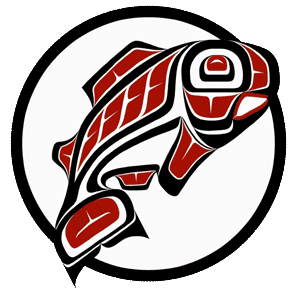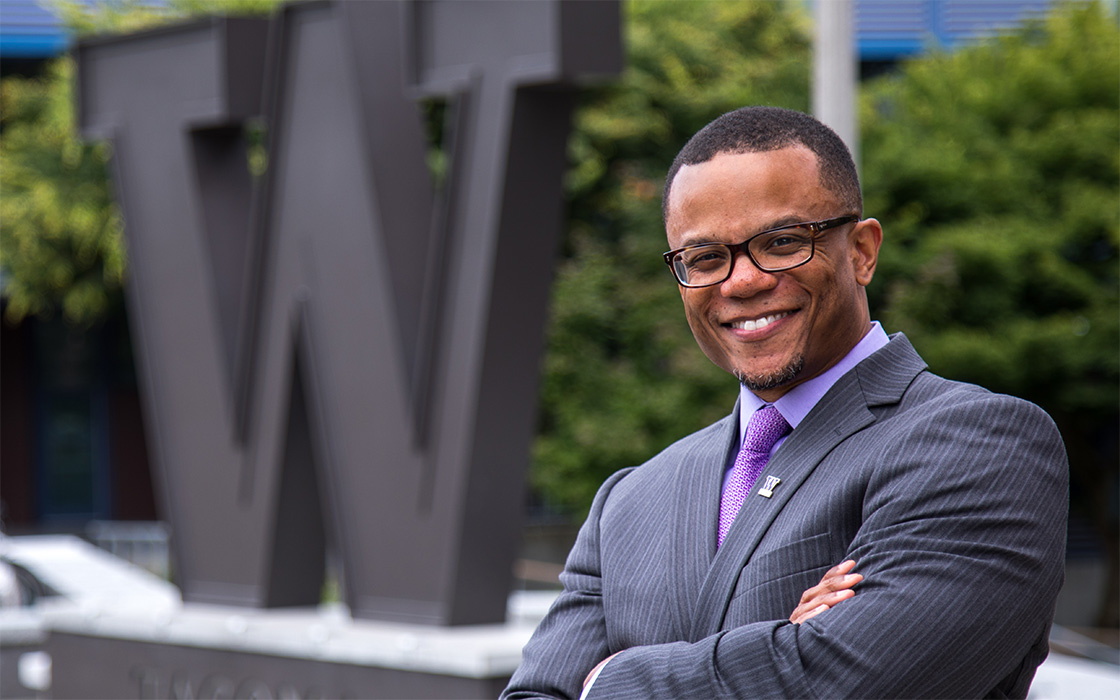
Meet Dr. James C. McShay
UW Tacoma’s newly-hired Assistant Chancellor for Equity & Inclusion speaks about his background, his first three months on the job and the opportunities ahead.
This Section's arrow_downward Theme Info Is:
- Background Image: ""
- Theme: "light-theme"
- Header Style: "purple_dominant"
- Card Height Setting: "consistent_row_height"
- Section Parallax: ""
- Section Parallax Height: ""
That James McShay is here at UW Tacoma seems to a certain extent inevitable. A look at his resume and a conversation about his background reveals a seasoned, visionary professional at the peak of his powers. His lived experiences and his previous professional positions almost seem as if they were a checklist to prepare him for this moment: taking on the leadership of the UW Tacoma Office of Equity & Inclusion.
The office, guided over the past year by Dr. Deirdre Raynor, has been on an upswing. Under the able leadership of Interim Director Shaquita Humphrey-Pressley, programming at the office’s Center for Equity & Inclusion has tripled and a sense of continuity has been established. Last year, Chancellor Mark Pagano, responding to vocal student campaigning, announced a commitment to relocate and expand the Center, a task that now falls to Dr. McShay. Over the summer, McShay began a series of meetings with students, known as a charrette, as part of an inclusive design process that will result in a new physical space, national searches for three staff positions and enhanced educational programming and community advocacy initiatives.
Recently we sat down for a conversation about his relocation to Tacoma, and how his experiences growing up in New York City, going to school in Oswego and in Iowa, and working in a small upstate New York school district and at two large land-grant universities have prepared him for his UW Tacoma role.
(Questions and answers have been edited for length and clarity.)
Tell me a little bit about your biography. Where did you grow up, and where did you go to school?
I was born and raised in The Bronx, one of the five boroughs of New York City. It was a neighborhood called Williamsbridge, which is in north central Bronx, not too far from Co-Op City.
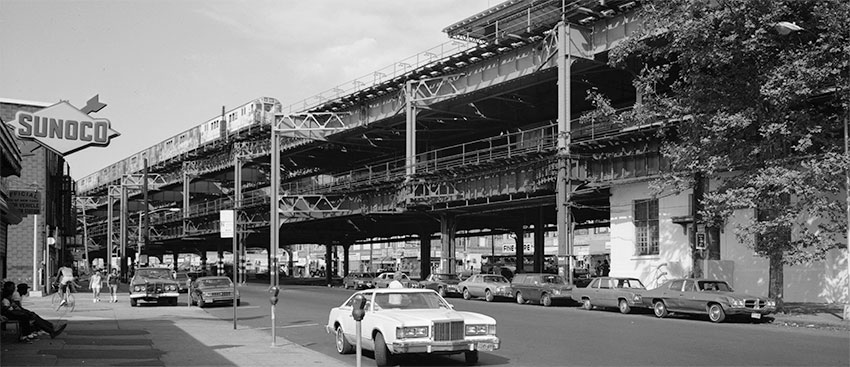
But where I really felt at home was in Harlem. That’s where my parents first lived in New York when they migrated up from the South in the early 1950s. They became very grounded in the community, very involved in their church. The church in Harlem was the one of the centers of the Black community as people were responding to institutional racism and political alienation on multiple fronts and also trying to figure out how to empower themselves economically.
My folks were always having conversations about what was happening around them. I remember all these discourses—at the dining table, in church, on the streets—where there was this resurgence of what it meant to have Black pride.
So I was living and going to school in Williamsbridge, which was mostly White at the time, and then on weekends and during the summers getting involved with the church community in Harlem. I was getting two conflicting messages from these different communities about how one should be in the world.
What were the conflicting messages you were getting?
From school I was getting a very individualistic message, and framed from a perspective of deficit, especially regarding people of color. In Harlem, I was taught about the value of community service, advocacy and caring for those who are disenfranchised. It was very disorienting, and it led me to have a very uneasy relationship with schools. There was a total difference in terms of how I felt as a young boy of color in the Harlem community where I felt affirmed and valued, and felt as if I belonged.
This was all when I was between the ages of 8 and 14. When it came time for high school, my mother, who had gone to college herself and was a registered nurse, and later a teacher, felt the public school options I had were limited. It was either a local high school, which weren’t of very good quality, or one of the New York City magnet schools, which didn’t offer a broad enough general education.
So I went to Cardinal Hayes High School, on the Grand Concourse in The Bronx, a private boys’ college prep school. That was a very different experience, with primarily Black and Latino peers, one where I felt free to learn more about myself and who I wanted to become. I appreciated it at the time and to this day. I didn’t feel as if I was in a school setting where I had to be prepared to do battle.
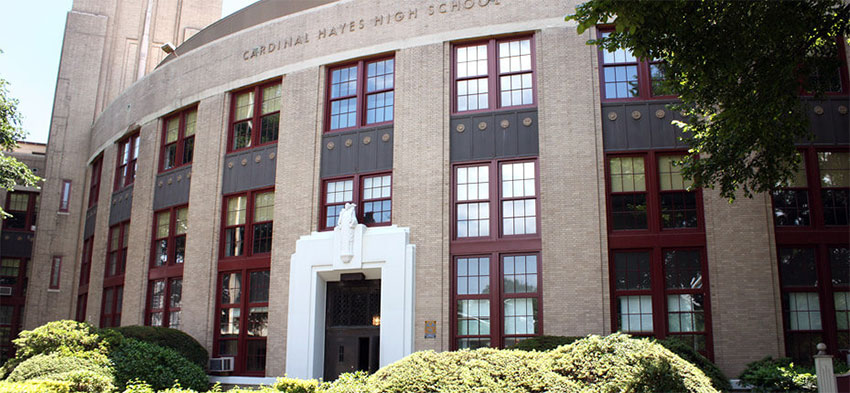
You went to college at SUNY Oswego, in a small town on the shores of Lake Ontario. What was that transition like?
I would say it was one of the most challenging experiences just being a Black male going to a school 300 miles away from New York City. 8,000 students, predominantly White, very rural. It was a very difficult transition for me trying to stay focused on my studies. I was dealing with a brand of racism that I hadn’t yet fully experienced.
I came to learn a lot about myself. I found a community in the Black student union and the college gospel choir. I would go to rehearsals and I knew I could just be myself and release all the anxiety and angst.
I was thinking about either becoming a journalist or a teacher. That’s one reason I had chosen SUNY Oswego, because of its strength in those two fields. I graduated with a degree in communication studies, and I assumed I would head back to New York City, but right after college I got a job as an assistant teacher working with sixth graders, many of whom were English language learners.
It was in a small town right outside Oswego, called Mexico, New York. The school had a large population of children who were part of migrant families from Mexico. I could see how their experience in school paralleled my own early school age experience. . They were afraid to speak their first language, Spanish, because their parents told them not to. Their parents knew that would subject them to treatment that was different from their teachers and their non-Latinx peers.
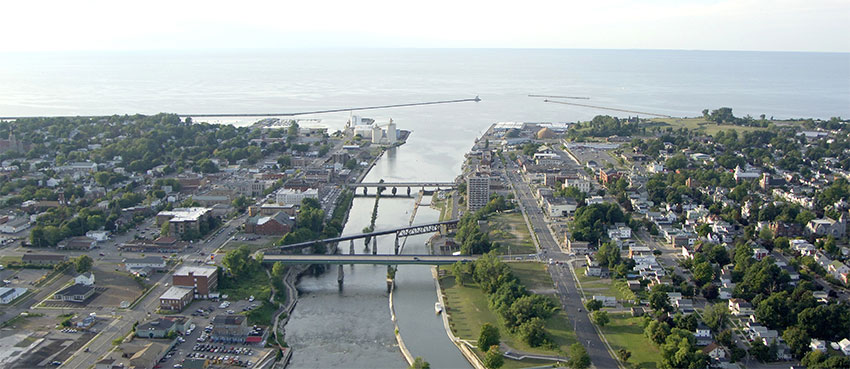
But these kids had been through so much. They traveled, they saw things and had experiences that were well beyond what their classmates knew. But none of that was honored in the classroom or taken into account in terms of how curriculum was designed. That was when I started thinking deeply about my experience and how it related to their experience. I suddenly had clarity around my own vocation, my purpose, if you will. I knew that whatever I did had to involve working in an educational environment.
And I realized that in order for me to do that work well I needed a credential.
How did you end up at Iowa State for your graduate degrees?
I went to a graduate fair in Syracuse, N.Y., and met an Iowa State advisor, Thelma Harding, a person who has now become a lifelong friend. She told me about their college of education. They had a program in multicultural and international curriculum studies.
My initial reaction was “This sounds great, but…Iowa?” It might as well have been on the other side of the earth. But she kept in touch, and told me about an assistantship with a stipend. I continued to think about it and came around to thinking maybe I should just go ahead and give this a try. I was secretly hoping I could get a degree and come back to Mexico, New York.
My two years at Iowa turned into 16. It’s where I got my Ph.D. and had my first professional academic positions.

By the time I got there, I had a different kind of emotional armor. I was better prepared to negotiate spaces that, at times, felt unwelcoming or indifferent to people of color. I’m convinced that came from connecting myself with those affinity-based groups at Oswego, and the support of my family over time.
That I persisted and succeeded at Iowa is due to five mentors who were like family members to me. Four were women of color and the fifth, my major professor, was a White woman. They coached me and advocated for me, put me under their wings and helped me understand how to navigate the political climate at Iowa and on a larger, national stage. The things they did for me are the things I want to do for our students and my colleagues.
You’ve been on the job for three months. What has struck you about UW Tacoma in that time?
First, I’ve learned of the significant work that has already been done here on this campus and at the larger university. There are a lot of assets to be tapped. The UW Diversity Blueprint, the Race & Equity Initiative, and our own UW Tacoma strategic plan, “Charting Our Course.” Our plan includes an equity impact goal and a significant amount of work has been done in terms of understanding what we should focus on as the indicators of success.
I think my task right now is to figure out how to organize the work in a way that’s cohesive and integrated. Part of this work is looking at ways in which we can align our efforts across the schools and the programs and connect them to work that’s happening through UW Tacoma’s and UW’s central administrations.
Prior to coming to UW Tacoma, you were at the University of Maryland, and before that at Iowa State. Those are two large land-grant universities with long histories. What is attractive to you about UW Tacoma?
This is the first time I have had the privilege of working on a campus that is relatively young. When you’re young, you’re positioned to grow and thinking about what you want to become. We’re answering the question, “Who do we want to be and how do we want to serve our communities?” That’s really compelling to me. At the places I worked previously, those questions of identity seemed to be less of a concern.
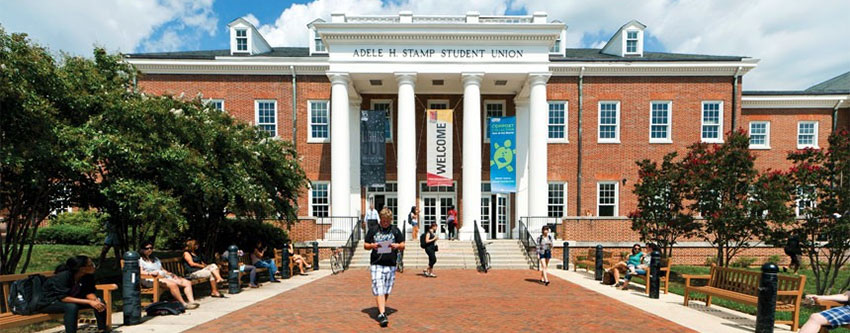
Here there is an effort to position our campus to be nimble, to be responsive and adaptive. That is really exciting.
What’s also really exciting is the compositional diversity that exists within our student body. That’s powerful in terms of the diverse set of lived experiences our students have that cross a range of identities and statuses.
I think we have the potential to create space for really deep learning engagement around the disciplines, but using the lens of the many stories that students bring as a result of their identities and experiences.
There is also a real opportunity for us to look at how we create more pathways to increase faculty diversity on our campus. How do we create inclusive classrooms? How do we help design curricula that is culturally responsive? How do we make sure that faculty have the tools, skills and knowledge base they need to do these things?
I’ve been hearing that you’ve hit the ground running here at UW Tacoma.
I met with a lot of people during the interview process leading up to my hiring, and it became clear there were some things that needed to be worked on over the summer.
One area is the bias incident reporting process. I convened a group of stakeholders, asking them to review our existing protocol and provide some recommendations. We’ve streamlined the process. Where once there was a two-tier review of reported incidents, we now have one tier. We will be updating the reporting website, and we will produce an annual report that summarizes the trends and frequency of incidents. We will launch trainings for the campus community in reporting bias incidents and we will have a series of trainings for the members of the committee that reviews the reported incidents.
On the programming side, we will be launching a new kind of program calendar for the campus community. We want to align our educational programming through the CEI with the history, heritage and identity-themed months that occur over the course of the year. We want to be inclusive and we want all members of our campus community to feel they have a stake in programming. We want to give visibility to the programming that is going on in the academic units just as much as the programming that CEI originates. And I think we have an opportunity to make sure our programming gives voice to communities big and small. We can create space for people whose lived experiences are shaped by their intersecting identities to tell their own stories.. What does it mean to be Black and queer? What does it mean to be Black, queer and first-generation?
On the staffing side, we are launching national searches for three positions in the Office: a permanent director of the CEI, a native and indigenous community liaison and a mentor and retention specialist who will work directly in the CEI.
This summer, we hosted a charrette—an intensive design process—for the Center for Equity & Inclusion. Our campus planning folks and architects from the community are working with the results of that charrette to help us reimagine what a CEI physical space can look like. It should serve as a hub for engagement, connecting students with faculty, staff and members of the community, who will come together to engage in educationally purposeful conversations and activities around race, class, gender, sexuality, ability, faith and other intersecting identities and experiences. We will have sessions in October to invite students and the rest of the campus community to see the work that got done during the summer and provide additional input.
It sounds like you’ve been very busy and have a great start on your vision for what can be done at UW Tacoma.
It’s clear through my being here for three months and having dozens of conversations with students, faculty, staff and members of the community that there’s a real sense of urgency around this work for our campus.
We want to be responsive and act. I’ll be doing lots of listening. The other part of this is conveying that this work can’t be done alone or in isolation. We all have to roll up our sleeves and be engaged and just do the hard work. Our students, faculty and staff deserve an environment that fully embraces their identities, allowing them to bring their whole selves to campus. I’m happy to be in this role and happy to work alongside others to shepherd the work.
Recent news
Main Content
Gathering Strength
News Tags on this arrow_upward Story:
- None
Main Content
UW Tacoma Enrollment up 4% for Autumn 2024
News Tags on this arrow_upward Story:
- None
Main Content
Celebrating First Gen
News Tags on this arrow_upward Story:
- None



